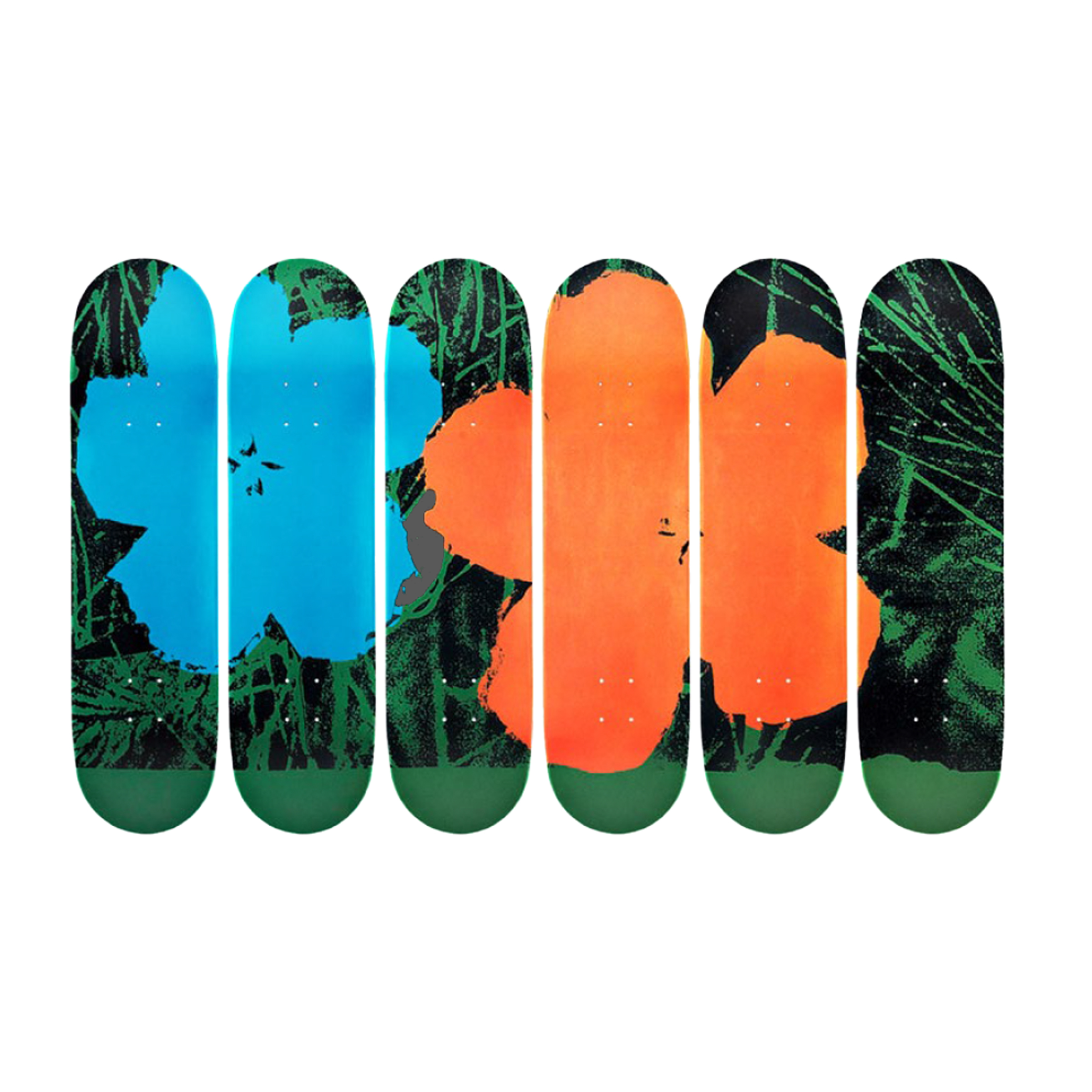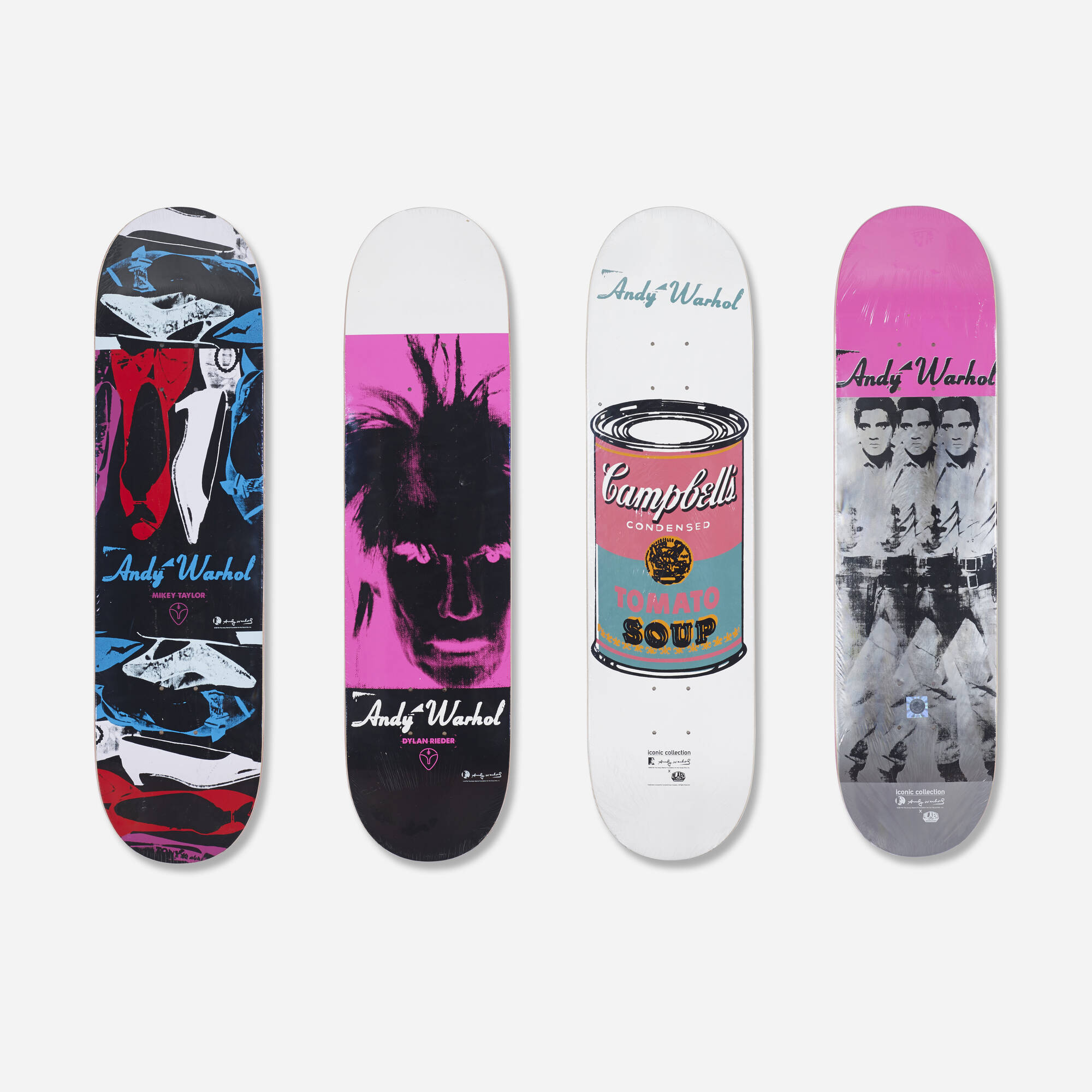You know what's crazy? The guy who painted soup cans and called it art actually revolutionized how we think about skateboard design. I mean, when I first started DeckArts four years ago in Berlin, everyone asked: "Why Renaissance masters?" But honestly, Warhol proved decades earlier that any image becomes art when you change its context.
Actually, this is something I've been thinking about since my Red Bull Ukraine days - Warhol understood mass production as art before streetwear brands even existed. He literally said "I want to be a machine," and now his silkscreen technique defines how we approach skateboard graphics.
Living in Berlin's art scene taught me one thing: Warhol's philosophy of making art accessible to everyone? That's exactly what skateboard wall art does today.

Alt: Andy Warhol Skateboard Collaborations: Art Meets Skateboarding
Why Warhol's Silkscreen Technique Revolutionized Skateboard Graphics
So let me tell you about silkscreen printing - it's the foundation of both Warhol's genius and modern skateboard deck production. According to MoMA, Warhol explained: "You pick a photograph, blow it up, transfer it in glue onto silk, and then roll ink across it so the ink goes through the silk but not through the glue."
That mechanical repetition? It wasn't a limitation - it was the the entire point. When I designed our Andy Warhol Marilyn Monroe Triptych, I wanted to capture how Warhol's repetitive imagery transforms individual portraits into cultural commentary. Three skateboard decks showing Marilyn's face in different color variations - that's pure Warhol philosophy applied to wall art.
The beauty of silkscreen on skateboard decks is its authenticity to Warhol's original vision. Skateboard manufacturing already uses similar printing techniques, so Warhol's aesthetic translates more naturally here than on traditional canvas reproductions. It's almost like... Warhol designed for skateboards before skateboards knew they needed designing.
Back when I was working with Ukrainian streetwear brands, we constantly referenced Warhol's production methods. Fast, repeatable, scalable - but somehow still maintaining artistic integrity. That tension between mass production and individual expression? It's exactly what makes Warhol skateboard collaborations work.
The Iconic Warhol x Skateboard Collaborations That Changed Everything
Here's where it gets interesting. Warhol died in 1987, but his estate and foundation have created some of the most sought-after skateboard collaborations in art history.
The Skateroom Partnership: Licensed by the Warhol Foundation, The Skateroom produces museum-quality decks featuring Campbell's Soup, Marilyn Monroe, skulls, and Warhol's other iconic imagery. These aren't cheap knockoffs - they're officially sanctioned art objects that generate funds for skateboarding charities.
Supreme Collaborations: When Supreme released Warhol decks, the secondary market exploded. Original releases now sell for $300-$800, proving that Warhol's name carries weight even in street culture.
Contemporary Collections: That's where DeckArts comes in. Our Andy Warhol Michael Jackson Diptych captures Warhol's celebrity portrait technique - bold colors, high contrast, that distinctive silkscreen aesthetic spread across two Canadian maple decks.
What makes Warhol perfect for skateboard art? His subjects were already mass-culture icons. Marilyn Monroe, Campbell's Soup, Michael Jackson - these images were designed for reproduction and recontextualization. Putting them on skateboards just continues Warhol's mission of democratizing art access.
As I explored in my Instagram is Driving the Wall Art Revolution article, social media transformed how people discover and purchase art. Warhol predicted this in the 1960s when he said everyone would be famous for fifteen minutes. He just didn't know Instagram would make it literal.

Campbell's Soup to Celebrity Portraits: Warhol's Best Skateboard Designs
Actually, funny story - when I first pitched Warhol-inspired pieces to collectors, they said: "Why would anyone want soup cans on their wall?" Then I showed them how Warhol's Campbell's Soup series now sells for millions at auction, and suddenly everyone understood.
Campbell's Soup Decks: The Skateroom's soup can series ranges from $150-$300 depending on which flavor. Collectors love them because they represent Warhol's breakthrough moment - the piece that made everyday objects acceptable as fine art.
Marilyn Monroe Series: Our triptych version captures Warhol's most famous celebrity portrait across 256 cm of Canadian maple. Three panels, five cm gaps between them, creating this panoramic pop art statement that dominates entire walls. As Andipa Gallery notes, even a single silk-screened print imparts a sense of repetition, and Warhol magnified this into a central theme.
Michael Jackson Portraits: The diptych format works perfectly for Warhol's Michael Jackson series. Two decks, 171 cm total width, capturing that electric energy of pop culture celebrity through Warhol's high-contrast lens.
Working in graphic design taught me how Warhol's compositions are actually brilliantly simple. He understood that bold, flat colors read instantly from across rooms. When you're designing for skateboard wall art, that principle becomes crucial - pieces need visual impact from distance.
What's interesting is how Warhol's technique differs from Renaissance masters. Caravaggio spent weeks layering glazes for dramatic chiaroscuro. Warhol? He mechanically reproduced photographic images and called the process itself the art. Both approaches create powerful visual statements, just through completely opposite philosophies.
Investment Value: Are Warhol Skateboard Decks Worth Collecting?
From my four years in Berlin's collector scene (actually closer to five now, time flies), I've watched the Warhol skateboard market evolve. Here's the breakdown:
Vintage Supreme x Warhol (2010-2013): Original releases now command $300-$800 depending on condition and design. The Campbell's Soup deck from 2012? That's pushing $1,000 for mint condition with original packaging.
The Skateroom Editions: These officially licensed pieces range from $150-$400. They hold value better than unauthorized reproductions because the Warhol Foundation backing provides authentication and provenance.
Contemporary Inspired Collections: Museum-quality reproductions like our DeckArts Warhol pieces offer the aesthetic without the authentication headaches. You're paying for craftsmanship and design, not speculative investment potential.
Honestly, this mirrors what I wrote in my Why Skateboard Art is THE Interior Design Trend of 2026 piece. Younger collectors care more about living with art they love than storing investment pieces in climate-controlled vaults.
The the uncomfortable truth about Warhol skateboard investments? Unless you're buying vintage Supreme or authenticated Skateroom editions, you're really buying decorative art that happens to be on skateboard decks. And you know what? That's perfectly fine if you're honest about it.
 Alt: Andy Warhol Skateboard Collaborations: Art Meets Skateboarding
Alt: Andy Warhol Skateboard Collaborations: Art Meets Skateboarding
Pop Art Philosophy Meets Skateboard Culture: Why It Works
Here's what fascinates me about Warhol and skateboard culture - both reject traditional art world elitism. Warhol said art should be accessible and reproducible. Skateboarding says creativity belongs on streets, not just in galleries.
When Warhol created his Factory in the 1960s, he was essentially running the world's coolest design studio - mass-producing art, embracing commercial aesthetics, collaborating with whoever walked through the door. That's literally how modern skateboard brands operate. Supreme, Palace, even DeckArts - we're all continuing Warhol's mission whether we realize it or not.
My background in branding helps me understand why Warhol's aesthetic works so perfectly on skateboards. His art was always about surface, repetition, and immediate visual recognition. Skateboard graphics need exactly those same qualities. A deck hanging on your wall should make a statement from across the room, not require close examination to appreciate.
Compare that to Renaissance art on skateboards - when I adapt Botticelli or da Vinci for DeckArts, I'm translating intricate compositions meant for contemplative viewing into bold decorative statements. It requires careful selection of which details to emphasize. Warhol decks don't have that problem - his art was born for quick visual consumption.
Where to Buy Authentic Warhol Skateboard Art (And What to Avoid)
From my experience authenticating art for collectors, here's where to find legitimate Warhol skateboard pieces:
Authorized Sources:
- The Skateroom (official Warhol Foundation partner)
- MoMA Design Store (curated licensed editions)
- StockX (for vintage Supreme collaborations with authentication)
- Authorized galleries and retailers
Red Flags That Scream "Fake":
- No mention of Warhol Foundation or estate licensing
- Suspiciously low prices ($50 for "authentic Warhol deck")
- Sellers who can't provide authentication certificates
- Listings that say "Warhol-style" while charging premium prices
Actually, just last month someone contacted me about authenticating a "rare Warhol skateboard" they bought on eBay for €100. The print quality was terrible - blurry edges, wrong color saturation, cheap wood. When I explained it was unauthorized, they were devastated. The lesson? Buy from legitimate sources or accept you're purchasing decorative art, not collectible investment pieces.
Working with Ukrainian creative brands taught me: transparency about what you're selling matters more than pretending everything is a rare original. DeckArts never claims our pieces are Warhol originals - we're creating museum-quality reproductions that capture his aesthetic for people who want to live with pop art, not store it in a vault.

Alt: Andy Warhol Skateboard Collaborations: Art Meets Skateboarding
Warhol's Legacy: From Factory to Skateboard Wall Art
So anyway, what would Warhol think about his art on skateboard decks?
I think he'd love it. The guy wanted his art everywhere - on t-shirts, album covers, advertisements, wherever it could reach mass audiences. Skateboard decks hanging in living rooms? That's exactly the accessible, democratic art distribution he championed.
The best part about Warhol skateboard collaborations is how they maintain his core philosophy. Whether you spend $300 on an authenticated Skateroom edition or choose a contemporary reproduction, you're participating in Warhol's vision of art that escapes gallery walls and enters everyday life.
At DeckArts, we apply that same principle to Renaissance masters. Not everyone can afford million-dollar Caravaggios or travel to the Uffizi to see Botticelli. But everyone deserves to live with art that moves them, you know what I mean?
The real investment isn't financial appreciation - it's the daily joy of seeing something beautiful on your wall that makes you think, smile, or remember why art matters in the first place.
About the Author
Stanislav Arnautov is the founder of DeckArts and a creative director originally from Ukraine, now based in Berlin. With extensive experience in branding, merchandise design, and vector graphics, Stanislav has worked with Ukrainian streetwear brands and organized art events for Red Bull Ukraine. His unique expertise combines classical art knowledge with modern design sensibilities, creating museum-quality skateboard art that bridges Renaissance masterpieces with contemporary culture. Follow him on Instagram, visit his personal website stasarnautov.com, or check out DeckArts on Instagram and explore the curated collection at DeckArts.com.
Article Summary
This article explores Andy Warhol's revolutionary influence on skateboard art, from his silkscreen technique to modern collaborations with The Skateroom and Supreme. Drawing from my experience in Berlin's art scene and Ukrainian brand collaborations, I analyze why Warhol's pop art philosophy aligns perfectly with skateboard culture, what makes authenticated Warhol decks valuable ($300-$800 range), where to buy legitimate pieces versus avoiding fakes, and how his mass-production aesthetic revolutionized the intersection of fine art and everyday objects. The piece demonstrates how Warhol's democratic art vision continues through contemporary skateboard wall art.

